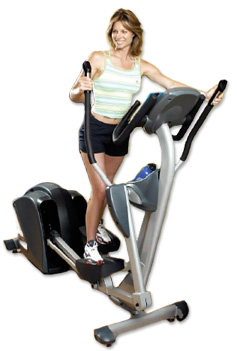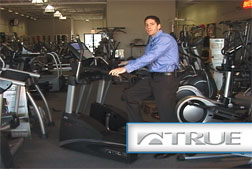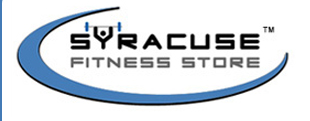|
|
|
|
|
[ Click here for a printable version of our current showroom models & pricelist ]
|
 |
As always, we strive to bring to you what we feel is the best on the market. Unlike the person at the sporting goods store that is selling you a product they had no decision in, we extensively search out to bring in the best machines within their price class. As you should, we look at the quality, the feel, the size, the look, the warranty, and the reputation of the company that is behind the product. With all that said, we feel that ultimately it comes down the feel of the machine. It has to fit and feel right or else you'll never use it. Every manufacturer has their own idea to what the perfect elliptical motion is. Every machines feel is uniquely different from the next. You can research all you want about ellipticals, but the best review is going to be you getting on the machines and trying them out. We have 15 different models on our floor for you to come in and try out. Prices will range from $499 to $5649.
Please read on for further detail of elliptical machines or click on the logos below to see in detail the products we offer.
 |
|
|
 |
TRUE TSXA ELLIPTICAL
DEMONSTRATION VIDEO
Let Syracuse Fitness Store Owner Andy Vendetti demonstrate the remarkable new features of the True TSXA Elliptical.
 CLICK HERE TO WATCH THE VIDEO.* CLICK HERE TO WATCH THE VIDEO.*
*REQUIRES WINDOWS MEDIA PLAYER TO VIEW.
|
|
|
|
|
Ever since the concept of an elliptical trainer was introduced in the mid-1990s, the equipment's popularity has grown exponentially. And no wonder: They are non-impact and the movement feels quite natural (like running or walking). Add upper body arms and your customer could have a non-impact, full-body workout that can satisfy everyone from total beginners to very advanced exercisers. Although they still haven't dethroned the treadmill as the equipment king, elliptical trainers are edging closer every year.
|
|
Why is it called an elliptical?
|
|
This could explain it all: an "ellipse" pattern sort of looks like a squashed circle or a bit like an egg. If you look at the movement of the feet from the side of someone on an elliptical, they are following that flatter circular pattern. The flatter the circle, the less the "bounce" or height in mid-stride someone will achieve; the higher the circle is, the more bouncy the movement will feel (more like a stepper almost). Some people will like the flatter and more even stride, while some will actually enjoy the fun of the bounciness.
|
|
|
How does it feel?
|
Someone may ask us which one is "best," but that is impossible to say really. Although certain models will be very adaptable to everybody and may feel good to more people, the smoothness, length of the stride, amount of bounce, distance of the arms from the exerciser, positioning of the console, and programs available, among other features could sway someone's comfort and opinion.
Typically, the shorter the machine in physical length from stem to stern, the bouncier the stride will be (since the egg shape has to shorten too), while the longer the machine is, the flatter the movement will be but not always. More and more companies are coming out with mechanics that allow shorter ellipticals to still have flatter patterns.
|
|
|
Will it fit in the house?
|
|
Some ellipticals can be nearly as much of a space-hog as a treadmill, requiring as much as 7 feet or so in length, so be sure to be aware of measurements. The height of the ceiling in the room the elliptical will be used in may be even more important. Because of the up-and-down movement provided by the rounder elliptical pattern, a user can be thrust higher mid-stride perhaps too high for low-ceiling rooms, attics or basement areas. Newer models and some brands have worked on this issue, introducing machines that are "low-profile" because of foot platforms that remain lower and therefore don't push a user so high upward.
|
|
|
Does a user want or need a full-body workout?
|
|
Many models these days have upper-body arms that attach to the sides of the front shroud and allow an exerciser to hold onto them and pull back and forth for additional upper-body exercise. This can be great for someone who normally doesn't get an upper-body workout and it may not be so great if someone regularly lifts weights. Make sure the arms are easily held without unnecessary reaching or straining. And if a you may not always use the arms, make sure there are stationary bars for them to hold onto.
|
|
|
Rear drive vs. front drive does it matter?
|
|
It's still all about feel, no matter where the drive is. What does matter is the overall size and the consumer's room space constraints since many rear-drive ellipticals (the ones with the mechanism in the back covered by a large shroud) can be quite demanding of space. Ellipticals with a front drive the foot platforms seem to just hang out from the shroud under the console can take less space, but it's also important that customers are aware of the moving platforms can endanger small kids or animals if they get too close when someone is on the elliptical working out. That risk can be minimized simply by telling the consumer to place the elliptical appropriately in the room so a pet or child cannot slip behind a user without his or her knowledge.
|
|
|
Other fit issues to check during a sale:
|
- Console -- The console, its controls and buttons should be within easy reach without straining.
- Foot platforms They should be large enough to move the feet forward or backward or in or out as needed for comfort; however, they should not be so wide apart that a user is forced to stand with feet farther apart than hips, putting a constant strain on glutes, hips, low back and knees. (Note: This can be especially problematic for women who normally have narrower hips, as well as legs that "angle in" slightly at the knee. Foot placement that is too wide adds extra torque in the wrong places to the lower body.)
- Stride length - Ranges offered vary from about 14 to 22 inches. If a user has longer legs or is tall, they'll want one with a longer stride length. Some runners may also prefer a longer stride length. A few brands allow a user to vary the length.
- Body lean Exercisers should feel as if they are walking or running naturally and very fluidly, and should not feel as if they are being forced to lean forward or backward -- or to unnaturally tense any lower-body or foot muscles to keep balanced.
- Step-up height With the height of foot platforms on some, users may have to step up pretty high to get on -- perhaps intimidating or awkward, especially if a user is short or if the elliptical is for someone who is older or less stable. Some foot platforms are low enough for more comfortable access.
|
|
|
Other variables worth pointing out:
|
- Resistance settings Variable enough to accommodate the user, from very easy to quite hard, and setting variability should be wide enough to accommodate needs as someone gets more fit or for others who may use the machine in the same household.
- Heart-rate monitoring As with most machines, there are two types, grip or telemetry. "Grip" means a user holds onto a specific place on handles with each hand and the pulse transmits to the console for readout. Sometimes movement can make these less accurate, just as can cold hands or poor circulation. "Telemetry" means a user wears a chest strap that reads a heart beat and the heart rate is displayed on the console. This feature can be quite motivating and educational for many users.
- Motivation -- Computerized controls, visual feedback and programs Does a user need motivation, such as a machine that will update progress and "cheer" on a user to different goals? Some brands have an array of pre-set programs that simulate hill climbing and different types of workouts, including use of upper-body arms, so a user doesn't have to think about it him- or herself a bit like a built-in personal trainer. Some also allow a user to input customized programs.
- Affordability Price can be a huge factor. Someone may be willing to trade up several hundred dollars if they are getting better fit and features. Above all else, don't sell on price, but on fit, feel and features.
- Console amenities It may seem like a minor detail, but someplace to put a water bottle, cell phone or pager, book or other necessities is pretty important.
- Power - Is it self-generating (no plug in required) or electrical? Make sure you know there is a plug nearby where the consumer is planning on putting the elliptical, if that's what they choose.
Because the feel and fit are so important with an elliptical, we encourage you to wear comfortable shoes and get on the machine(s) for at least 5 minutes. Then and only then will you know if it feels right.
|
|
[TOP]
|
|




